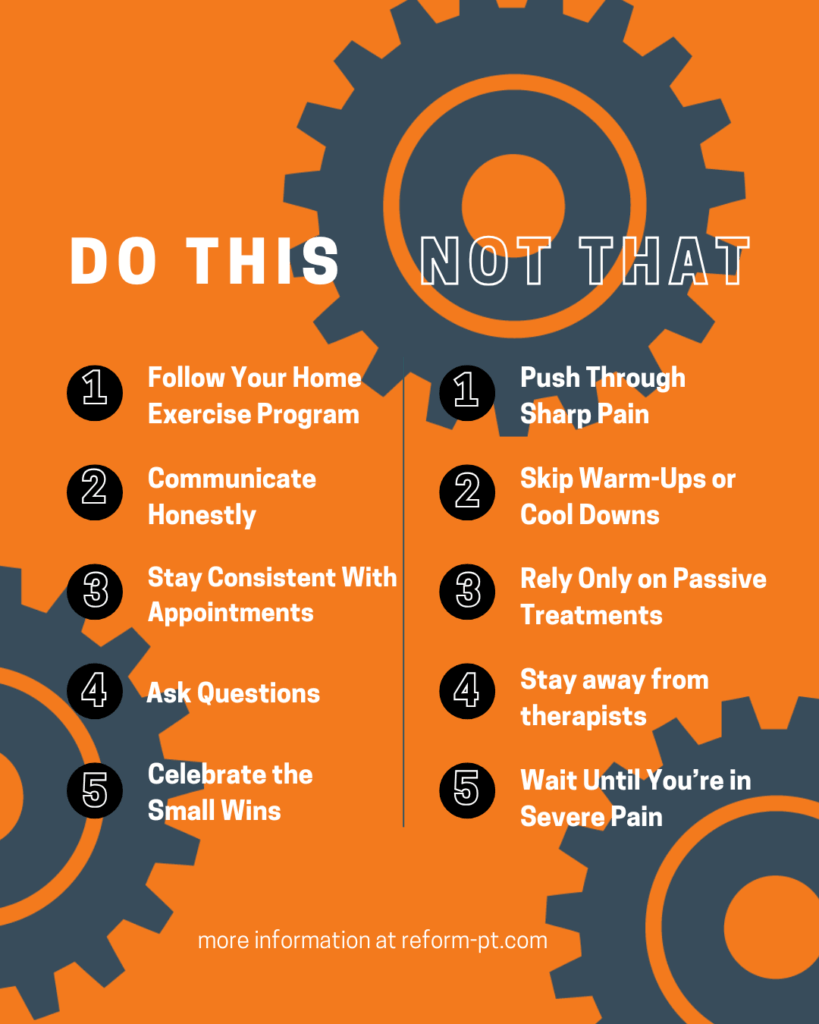The Do’s and Don’ts of Physical Therapy: A Guide to Optimizing Your Recovery
Posted by: Reform Physical Therapy in Injury Prevention on June 6, 2025
Whether you are beginning physical therapy for the first time or returning after an injury, understanding the do’s and don’ts of physical therapy is essential. At Reform Physical Therapy, we believe that patient education is just as important as the treatment itself. That’s why we’ve created this guide outlining the most important do’s and don’ts of physical therapy to help you stay informed, engaged, and on track throughout your recovery journey.
Below, we outline the fundamental do’s and don’ts of physical therapy to help you stay informed, committed, and on track to achieve your health goals.


The Do’s of Physical Therapy
1. Follow Your Home Exercise Program
Your individualized home exercise plan is an extension of your in-clinic care. These exercises are designed to support your progress by improving mobility, strength, and stability. Consistency at home is just as important as consistency during your scheduled visits.
2. Communicate Openly with Your Therapist
Clear communication is vital. If you experience increased pain, discomfort, or if something does not feel right during or after a session, inform your physical therapist. This allows us to adjust your treatment plan and ensure your therapy remains safe and effective.
3. Remain Consistent with Your Appointments
Adhering to your appointment schedule is essential for steady progress. Missed or irregular sessions can interrupt your recovery timeline and reduce the effectiveness of treatment.
4. Ask Questions and Stay Informed
Your physical therapist is here to support you not just physically, but through education as well. If you have questions about a movement, treatment method, or your overall plan of care, do not hesitate to ask. A well-informed patient is an empowered one.
5. Acknowledge Your Progress
Healing can be gradual. Improvements in mobility, reduced pain, or the ability to return to daily activities—even in small steps—are all signs of meaningful progress. Recognizing these moments can help maintain motivation and build confidence.
The Don’ts of Physical Therapy
1. Do Not Push Through Sharp or Severe Pain
While some discomfort during rehabilitation is expected, sharp or sudden pain is not. Always stop and report any unusual pain during exercises or treatments. Pain is your body’s way of signaling that something may be wrong.
2. Do Not Compare Your Recovery to Others
Each individual’s body heals at its own pace. Factors such as age, activity level, type of injury, and general health all influence recovery. Focus on your own improvements and avoid comparisons that may discourage or mislead you.
3. Do Not Skip Warm-Ups or Cool Downs
Warming up prepares your muscles and joints for movement, while cooling down supports recovery. Both are important parts of a safe and effective therapy routine, whether in the clinic or at home.
4. Do Not Rely Solely on Passive Treatments
Modalities such as heat therapy, massage, or electrical stimulation can provide temporary relief. However, long-term results come from active engagement in rehabilitation exercises that build strength, improve mobility, and restore function.
5. Do Not Delay Treatment
Early intervention is often key to faster recovery. If you are experiencing pain, stiffness, or limitations in your movement, do not wait until the condition worsens. Consulting with a physical therapist early can prevent further injury and support better long-term outcomes.
Conclusion
Successful physical therapy is a collaborative effort between you and your therapist. By understanding and applying these essential do’s and don’ts, you can take a more active role in your recovery and improve your chances of achieving lasting results.
If you are ready to begin your recovery journey or would like to learn more about how physical therapy can benefit you, please contact Reform Physical Therapy to schedule an appointment with one of our experienced clinicians.
